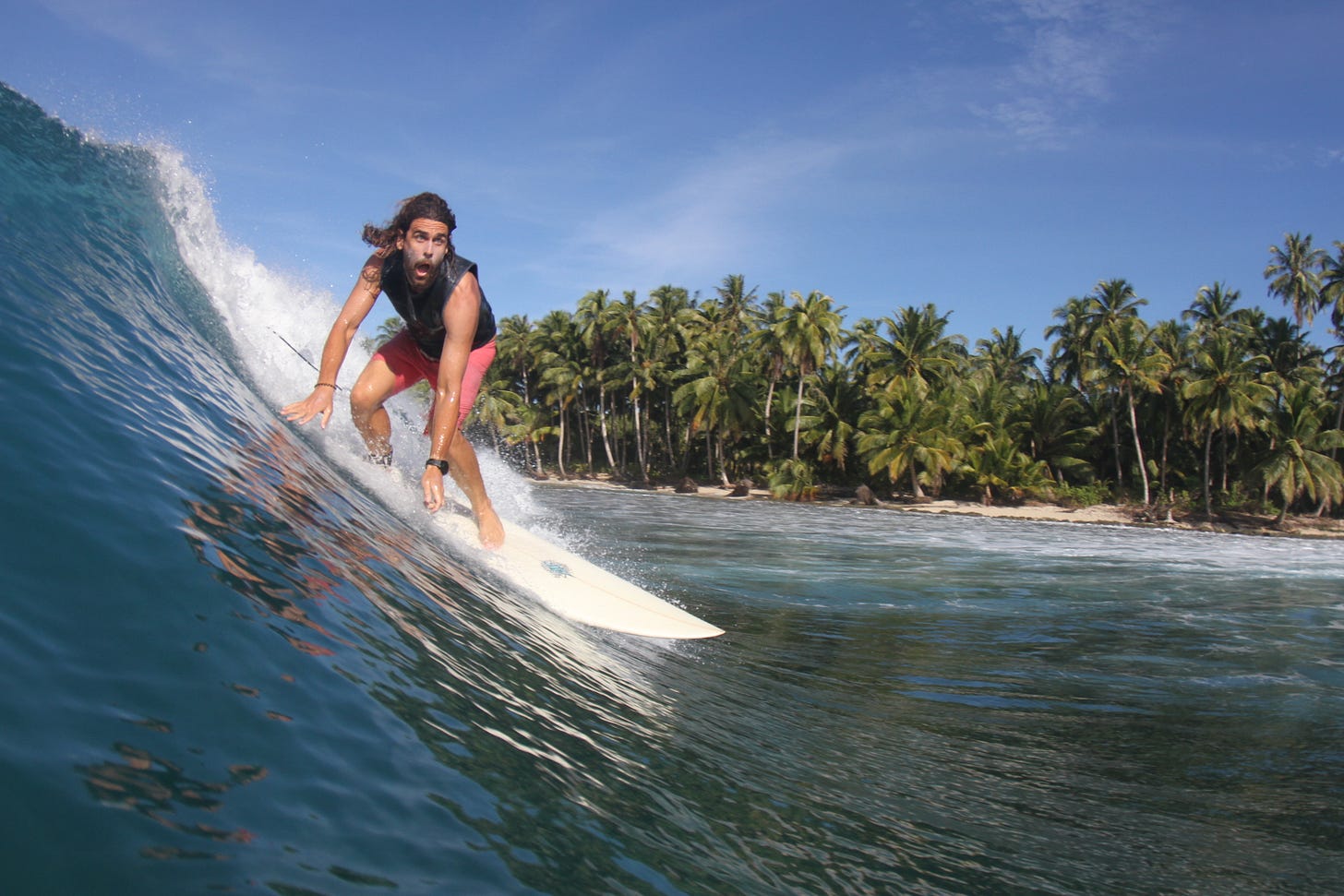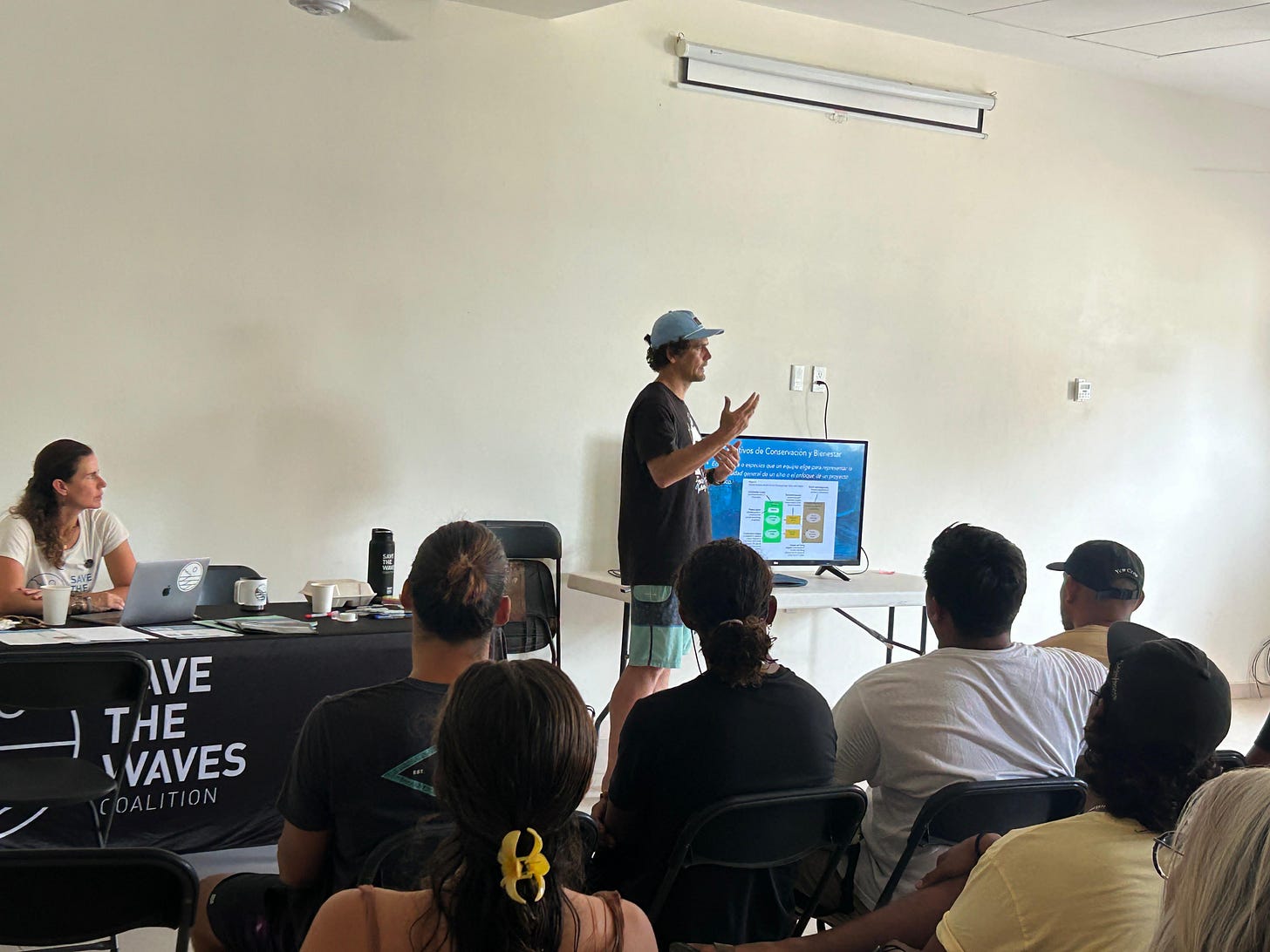“You can’t control where people choose to surf.”
An interview with Trent Hodges of Save the Waves, who lives in Santa Cruz, California
“You can’t control where people choose to surf – that’s part of the beauty of the surf experience – but you can think about the most important natural resources in each of these zones and ask how we protect these waves so they can handle an increase in visitors. And ask how we protect them from the impacts of climate change.”
I first heard about Save The Waves through Adam Hall, who helped make the North Devon Surfing Reserve a reality in 2023, and Dr Tony Butt, my first ever interviewee. As the name suggests, they do excellent work in protecting surf ecosystems around the world and encouraging coastal stewardship.
So I was super excited to interview Trent Hodges from the organisation, who is a senior manager working on World Surfing Reserves & Campaigns. We chatted about the growth of surf tourism – including some examples of where Trent thinks it’s been managed well –, the importance of working with local communities, and how surfers can be responsible travellers. Enjoy!
Hey Trent, how’s the surf been lately?
Gosh, I’m embarrassed to say I just got back from a work trip to Mexico and I didn’t even get a chance to surf! Sometimes this work is very demanding and doesn’t leave much time for play, but I am itching to get in the water this week back at home in Santa Cruz.
How does an area become a World Surfing Reserve?
It works as a process, where places build their proposals with us over time. The World Surfing Reserves program has a strict set of criteria for eligible surf zones and an outside “Vision Council” selects one each year.
We only work with places that ask us to help them – The whole model is based on a community and grassroots driven approach – and a lot of the reserves apply year after year, as it’s quite competitive.
Surf tourism is clearly booming around the world. What challenges come with that?
There are areas which have been hidden secrets for years and only known to a few surfers and then suddenly they’re on the map. That does bring a lot of challenges, because often these surf towns don’t have the infrastructure to support the waves of people who are suddenly visiting. You have environmental and crowding impacts on not just the wave but the wider coastal ecosystem.
Surfing is growing in popularity and one of the things we advocate for with Save The Waves, whether we’re talking about a World Surfing Reserve or Surf Protected Area or even a specific campaign, is that surf tourism can bring a lot of benefits, as long as proper planning for that expansion and growth is put in place. You can’t control where people choose to surf – that’s part of the beauty of the surf experience – but you can think about the most important natural resources in each of these zones and ask how we protect these waves so they can handle an increase in visitors. And ask how we protect them from the impacts of climate change.
What are some success stories when it comes to managing surf tourism?
Huanchaco in Peru is a World Surfing Reserve that is an interesting success story. There was so much trash on their beaches, and part of that was because there was a nearby landfill that wasn’t properly disposing of their waste. And so, the whole community rallied together to move the landfill away from the beach and Save the Waves kickstarted that whole campaign process.
I would say there are two kinds of routes, there is the political organising component, where surf communities can really get involved and make a change in infrastructure involving waste management, or you can dial down and look at what the actual source of pollution is and how to prevent that waste from reaching the beach.
North Devon is a good example of that, as we’re running these willow leaky dams, woody debris dams and willow tree restoration that will restore watershed habitat as well as filter polluted run-off and collect a lot of the plastic that comes from the land.
A lot of our World Surfing Reserves are working on education, so educating local people on alternatives to plastic and how to dispose of plastic properly. But it’s a constant fight. In Central America, a lot of the plastic comes from upstream, so when it rains it comes down the rivers and floods the beaches.
Plastic pollution is a global scourge and something that’s super challenging to tackle as it’s really a problem of production and the fact that so much plastic gets put into our lives on a daily basis, when lots of places don’t have the infrastructure to deal with it.
It’s very hard to fix that problem locally but in Oriente Salvaje in El Salvador, which is the newest World Surfing Reserve, they’ve been working in partnership with the World Surfing League, to develop river barriers in some of the smaller watersheds so when it floods all the plastic gets collected there and doesn’t reach the beach.
So, you have the large-scale problem where we need to stop making so much plastic, which is hyper-political, and then you have the smaller scale stewardship solutions, where we work closely with the grassroots folks on the ground trying to implement solutions.
Where does surfonomics fit in?
The economic benefits that surf tourism brings can be a powerful lobbying tool for local communities and helpful for surfers in terms of advocating for their communities and preserving their coastal ecosystems at a local level. Dr Jess Ponting at San Diego State University is one of the world’s foremost experts on Surfonomics, and he’s developed a framework which helps local businesses develop without harming the local environment, either through producing plastic or impacting water quality.
At Guarda do Embau, a World Surfing Reserve in Brazil, we did a surfonomics study as before they’d done studies on dive tourism and other sorts of recreation, but not surfing. We shared how much money surfing was bringing into the community and thanks to that information, we’re hopefully going to be working together to build a wastewater treatment plant.
Water quality is one of the big concerns that comes up in surfonomics studies and that information is extremely valuable because locals don’t want surfers to not visit their areas because the water quality is poor.
What other threats affect surf ecosystems?
So many, but certainly climate change will affect all surf ecosystems in a myriad of different ways. Sea level rise will impact the physical waves especially at reef breaks and tide-sensitive areas and the increase in storm activity and changing weather patterns are a threat to the communities and their ecosystems.
We have a World Surfing Reserve in Playa Hermosa in Costa Rica. It’s low key but there are lots of development threats in that zone as well as the impact from changing weather patterns– you have these natural systems, like wetlands and mangroves, which are amazing at filtering water and are really good for flood resilience when it’s stormy. We’ve been working on restoring their watersheds and trying to protect these wetland ecosystems which are essential to the wildlife as well as formation of the coast and waves.
What about Bali?
In terms of surf tourism, Bali is an example of a place which everyone flooded to visit, and then you have the government moving forward with plans to develop Uluwatu. [I interviewed Balinese surfer Piter Panjaitan about the development threats to Uluwatu here.] Part of that is that they don’t value surf tourism anymore because they think it’s gone too far and destroyed things in a lot of ways. We’ve been working with our partners to see how we can influence things but it’s very political and hard to know exactly what is going on behind the scenes as the government hasn’t said much.
I think they have an alternate plan for tourism that they haven’t shared with the community. But it’s one of the most famous and cherished waves in the world, so it’s really tragic.
But one of the things we’re learning is that every country is so different and building the trust between local surf communities, local and even national government is so important because when development plans change you have that basis of understanding and the tools to understand why this surf ecosystem is so important.
And finally, how can we as surfers be responsible surf travellers?
Surfers are pretty good at that because we love these places. We go and travel there because they’re so beautiful and they bring us such a sense of joy and contentment, but I think really learning about the issues that are happening locally and seeing if there’s a way you can get involved or support can only be helpful.
With World Surfing Reserves, there’s so much going on and if you can engage with that and support it and spread the word about the work they’re doing. We have an app that’s a really good tool that surfers can use when they travel. It’s a way to document any specific threats you see; you can take a photo and then choose the threat from a drop down menu. It’s really simple and gets loaded into our database and we can get that information out to our local partners. Surfers are like fishermen in that sense because they’re in the water the whole time, so they really see what’s happening.
And then of course you can try and minimise your impact and not bring a bunch of plastic down to the beach and be mindful of your surroundings. Recognise that you’re a visitor to that place, and there's people there that have stewarded these resources for generations, and you’re coming into their place. How can you ensure that you're not leaving it in a worse way than you found it?
Head to Save the Waves to find out more.
Here’s a piece I wrote for Huck on North Devon’s World Surf Reserve.
Last month’s interview with Steve Wall also looked at what happens when waves sadly aren’t protected, in this case in Iceland.
And this feature, which I did for Conde Nast Traveler in the US earlier this year, gets into Morocco’s surf tourism boom and how the local NGO Surfrider Foundation Morocco is lobbying the government to protect beaches from marine litter.
Other news:
Final call for the annual Surfers Against Sewage Paddle Protests on Saturday 15th May. I’ll be at the Brighton one & UK readers, you can find your nearest protest here. They really are a visual spectacle that helps keep the issue of water quality (or lack of it!) in the news & a super powerful event to be a part of.
And I enjoyed reading the shortlisted entries for this year’s Looking Sideways (
) x Db talent fund, especially as the finalists include my great old pal Tristan Kennedy, with a super interesting idea about a ski tour business owner who refuses to leave an abandoned ski resort, and a project by the awesome Bella Bunce to tell the story of Yvette from Wave Wahines, who I interviewed here, and how her quest to learn more about her biological roots led her to connect with a women’s surf school in Bangladesh. Read more about both ideas and see the full list here.ps Sign this petition to ban octopus farming in the EU here.
Please fwd this newsletter to anyone who you think might be interested & if you have any story tips on any of these themes pls get in touch.







Thanks for sharing Sam